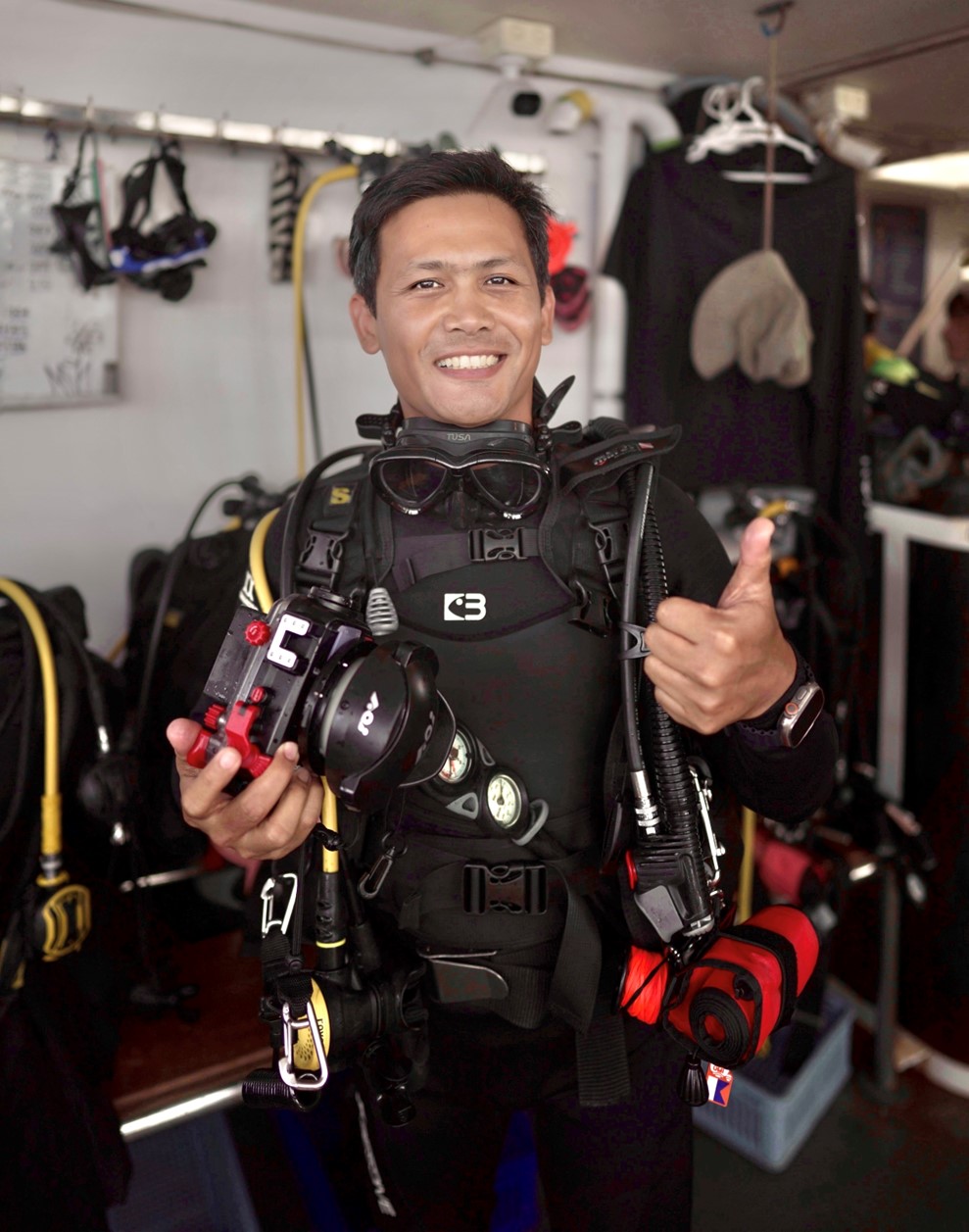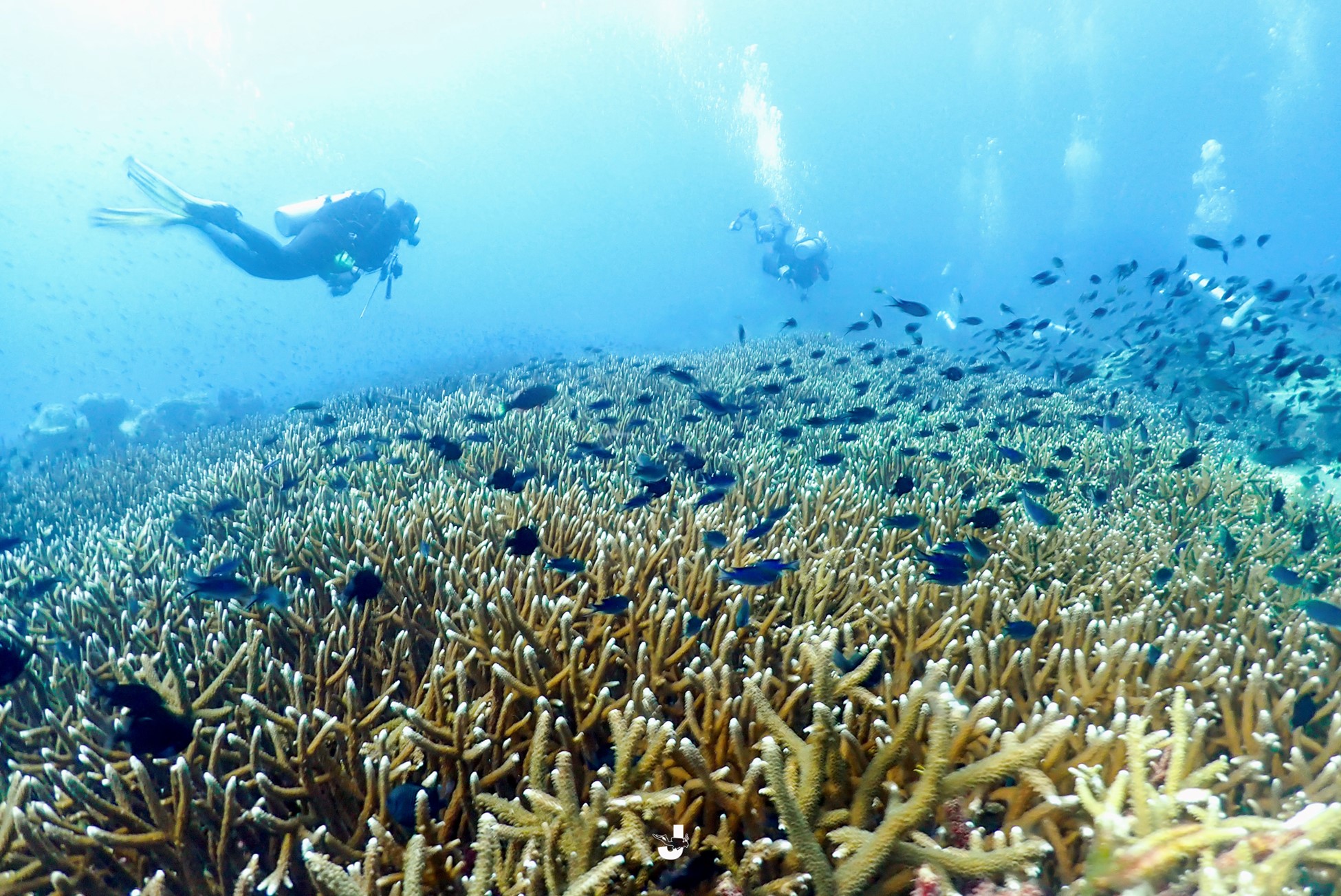Humanity in Symbiosis: Lessons from the Deep
Jakkrit Sangkhamanee04/15/2024 | Reflections
Last February on a stage at TEDx Chiang Mai, Thailand, I was privileged to be able to stand on a red-dot carpet delivering my talk as an STS anthropologist and advanced scuba diver working to understand posthuman interconnectedness. On the stage, I shared a journey that began as a dive into human culture and morphed into an immersion into the depths of the ocean. As an anthropologist, my work is predicated on observation, a deeply embedded look into the intricacies of human societies, and the unspoken contracts that bind us to our environment. But it was the discovery of my own vulnerability to depression and the therapeutic solace I found in scuba diving that took my understanding of human connectivity to another level. This blog post is a reflection of that odyssey, a contemplation on our relationship with technology and the environment.
The process of strapping on a scuba diving gear and descending into the blue ocean in the deep south of Thailand is akin to donning a space suit and exploring another planet. It is here, in this alien world, that the construct of being a cyborg—a seamless amalgamation of human and machine—becomes more than a theoretical concept. Each dive has been an anthropological expedition, revealing to me the reciprocal bond we share with technology and through it, with the marine life around us.

Figure 1: A cyborg anthropologist [credit: Jakkrit Sangkhamanee]
The technological advancements in diving gear have enabled us to extend our natural capabilities, to explore and study ecosystems that were once beyond our reach. This equipment, while non-living, becomes a vital part of us, a lifeline. As I became a creature of both biology and technology, I realized that this human-machine symbiosis was symbolic of a larger, more profound connection to our world.
Underwater, where the light refracts and communication is reduced to gestures, one learns the language of simplicity and necessity. Here, the complexity of human speech and culture is distilled into the essential. This, in turn, echoes the simplicity yet complexity of the interactions among the coral polyps I observed at Losin, a site that is not widely known but holds one of Thailand's largest coral reefs. These polyps, with their tiny, vibrant tentacles, come alive at night, stretching out from their calcium carbonate homes to feed. They are a community that thrives on cooperation, each polyp providing for the others, each one necessary for the survival of the whole.

Figure 2: Staghorn coral field in Losin, southern part of the Gulf of Thailand [credit: Jakkrit Sangkhamanee]
The animal-plant symbiosis of coral and algae is a delicate dance of survival, each relying on the other for food, waste removal, and the construction of their protective homes. It is a multispecies partnership that illustrates how life on our planet flourishes through mutual support and intertwined destinies. However, just as coral polyps expel their life-sustaining algae when stressed by changes in their environment, so too does humanity risk severing its crucial bonds with nature due to environmental stressors.
Coral bleaching is a stark visual metaphor for this breakdown in the relationship, an indicator of how the Anthropocene—this human epoch—is reshaping our planet. As the seas warm even slightly, the once vibrant coral communities are left pale and lifeless, a reminder of the fragility of the life systems that sustain us all. The perils faced beneath the waves are not isolated events; they signal a broader ecological crisis that impacts the life on the surface, including our own.
In our current age, the role of anthropology in the STS field expands beyond human society to encompass all life forms, their interactions, and the shared environment. It is a call to adopt a posthuman view, recognizing that human culture is deeply enmeshed within the more-than-human world. We are part of a web that extends across species and elements, a web that is being strained by our actions and inactions.
As I concluded my talk in Chiang Mai, I reflected on how observing nature and diving among corals had offered me a new lens to understand humanity. In a world where vast expanses are underwater realms not meant for human habitation, there is much we can learn about cohabitation, adaptability, and the art of living together.
The message I wish to impart is one of humility and change. As we face the challenges of the Anthropocene together, it is crucial to recognize our interdependency with the myriad forms of life that share our planet. The coral reefs, with their complex symbiotic relationships, stand as a testament to the power of community and collaboration. By embracing our position as part of a larger ecological community, we can begin to reshape our actions and our societies towards a more sustainable and equitable future.
This is more than a call for environmental stewardship; it is a call to reconsider our place in the natural order of things. To learn from the coral polyps and the technology that grants us passage into their world. To recognize that in our drive to survive and thrive, we must nurture the very connections that sustain us. Only then can we hope to find balance in the Anthropocene, navigating a world that we influence profoundly, and that, in turn, shapes our fate.
Coral bleaching is a stark visual metaphor for this breakdown in the relationship, an indicator of how the Anthropocene—this human epoch—is reshaping our planet. As the seas warm even slightly, the once vibrant coral communities are left pale and lifeless, a reminder of the fragility of the life systems that sustain us all. The perils faced beneath the waves are not isolated events; they signal a broader ecological crisis that impacts the life on the surface, including our own.
In our current age, the role of anthropology in the STS field expands beyond human society to encompass all life forms, their interactions, and the shared environment. It is a call to adopt a posthuman view, recognizing that human culture is deeply enmeshed within the more-than-human world. We are part of a web that extends across species and elements, a web that is being strained by our actions and inactions.
As I concluded my talk in Chiang Mai, I reflected on how observing nature and diving among corals had offered me a new lens to understand humanity. In a world where vast expanses are underwater realms not meant for human habitation, there is much we can learn about cohabitation, adaptability, and the art of living together.
The message I wish to impart is one of humility and change. As we face the challenges of the Anthropocene together, it is crucial to recognize our interdependency with the myriad forms of life that share our planet. The coral reefs, with their complex symbiotic relationships, stand as a testament to the power of community and collaboration. By embracing our position as part of a larger ecological community, we can begin to reshape our actions and our societies towards a more sustainable and equitable future.
This is more than a call for environmental stewardship; it is a call to reconsider our place in the natural order of things. To learn from the coral polyps and the technology that grants us passage into their world. To recognize that in our drive to survive and thrive, we must nurture the very connections that sustain us. Only then can we hope to find balance in the Anthropocene, navigating a world that we influence profoundly, and that, in turn, shapes our fate.
Jakkrit Sangkhamanee is an associate professor in anthropology at Chulalongkorn University in Bangkok, Thailand, with a background in science, technology, and society (STS). His previous research interest lies in exploring the socio-political dynamics of hydrological projects and environmental infrastructure within the intricate matrix of Thailand's climate debates and water politics. An avid scuba diver, he integrates his underwater explorations into his fieldwork, recently authoring a book in Thai entitled "Thalasso-anthropology: An Ethnography of Technology, Multispecies, Materiality, and Speculative Story Under the Ocean," which sheds light on the submerged connections shaping our world.
Published: 04/15/2024
